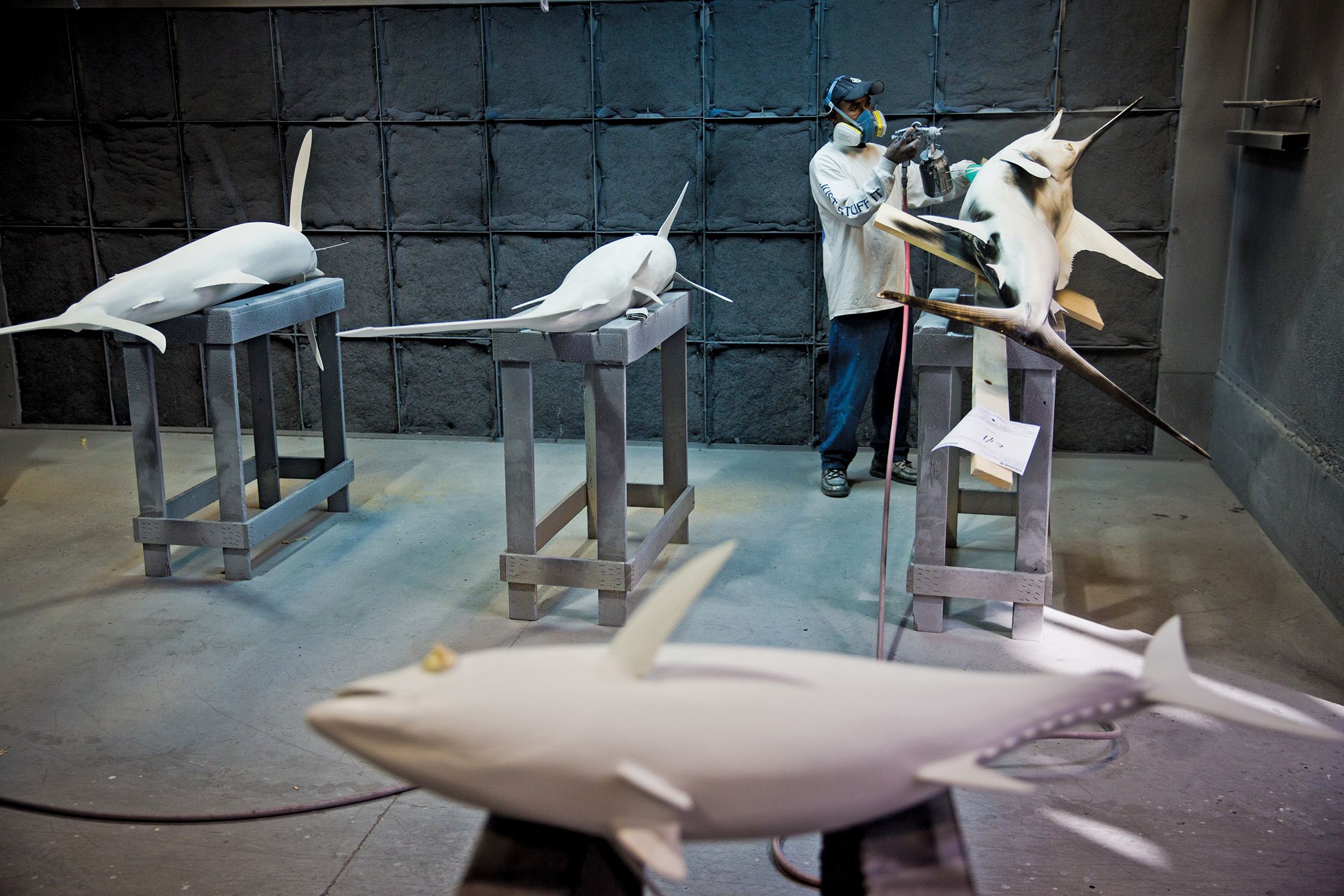By Lola Thélin
Photography by Scott McIntyre
For anyone not familiar with fishing, this may come as a surprise: There’s an art to the sport, even after the catch. This is evident at Gray Taxidermy, a South Florida-based marine taxidermy company that has made custom fish mounts for more than half a century.
“The guys in the back of the shop are artists,” says Bill Dobbelaer, the company’s general manager. “They are painting and sculpting.”

MASTER CRAFTSMEN: Each of the custom fish at Gray Taxidermy is produced by hand by skilled artisans, including Leo Lampone, who is also seen working on the pieces at age 7 (inset).
Although it’s labeled as a taxidermy business, the company no longer stuffs fish. Traditional taxidermy—the practice of treating dead animals—was Gray Taxidermy’s business model 50 years ago. Now there’s no need to use formaldehyde and other overwhelming chemicals. Instead, fiberglass custom fish are crafted from molds that were created from real fish and then painted to look like the real thing.
“The production is typically 100 percent replica,” Dobbelaer says. “We don’t usually use real parts or skin. The teeth are made from acrylic, and the eyes are made of glass.”
Technically the fish are reproductions, but there’s plenty of history floating around, mainly related to the most famous fish of them all. In the 1970s, shark fisherman Frank Mundus, who is said to have inspired the character Quint in the hit film “Jaws,” caught a giant shark off the coast of Montauk, New York. At the time it was a world record, Dobbelaer says. Gray Taxidermy was hired to make a mold of the jaw, and founder Bill Gray and a 16-year-old employee flew north to create it.
“This is Disney World for people who fish.” —Bill Dobbelaer

GO FISH: With 50 years in the business, Pompano Beach’s Gray Taxidermy has become the world’s largest marine taxidermy company.
Gray Taxidermy found itself in shark-Mundus territory again in 1986, when a 3,450-pound great white shark was caught in Montauk from a fishing boat where Mundus served as skipper. The organs were donated to the Woods Hole Oceanographic Institution in Massachusetts, and a full-body replica was ordered from Gray Taxidermy to be displayed at Ripley’s Believe It or Not in San Francisco.
The majority of the Gray Taxidermy team is based in the Pompano Beach manufacturing facility, with marketing offices scattered from Cabo to Costa Rica to Cancun. In addition, the company maintains close relationships with charter captains around the world. Part of Gray Taxidermy’s success is its portfolio of fish: Near the main facility, the company has several warehouses filled with original molds—big fish, little fish, bait fish, fish from the Atlantic, Pacific and Caribbean. A single mold can be used to create hundreds of further reproductions with the same proportions. Clients can send their orders with a photograph of their catch and its measurements, along with a note about any specific marks to help the artists create a custom fish. Then the fish is mounted to the client’s preference.
The modern-day practice of marine taxidermy is fitting for most anglers, as it has a direct correlation with catch-and-release fishing. Both practices protect the species and are an integral part of the enduring vitality of fisheries.
To help further protect fish species and build awareness, two years ago Gray Taxidermy launched Gray FishTag Research, a nonprofit program that provides tags to track migration patterns, fish stocks and growth rates for scientific purposes. The nonprofit distributes thousands of free tags, applicators and data cards to more than 10,000 charter boat captains and mates and provides hands-on training. Every fish caught is tagged, and the data, from the species to the location, is recorded and submitted online at grayfishtagresearch.org. The person who catches the fish gets to name it; if the fish is recaptured, then that person renames the fish.
One of the program’s main objectives is transparency of data. It works with the National Oceanic and Atmospheric Administration, the University of Miami and Nova Southeastern University for research purposes and also shares the data with any interested parties at no cost. Gray FishTag Research also hired a full-time scientist to conduct studies. About 78 species of fish have been tagged so far, and their migration patterns are being documented.
Ultimately, Gray Taxidermy does real work with real people and prides itself on being a U.S.-based manufacturing company that produces its products one at a time by hand. Their products hang in museums, restaurants and homes. Recently, a group of Russian friends went deep-sea fishing and spent thousands of dollars in the freight shipping of fish mounts alone—but it’s not about the records, whether that means trophy catches or shipping costs.
“It’s about the people,” Dobbelaer says. “If you bought a million dollars’ worth of fish mounts from us, it’s still not the same as $100 from a kid who caught his first fish with his dad. That’s who we are. This is Disney World for people who fish.”
Originally appeared in the Spring 2017 Issue.






